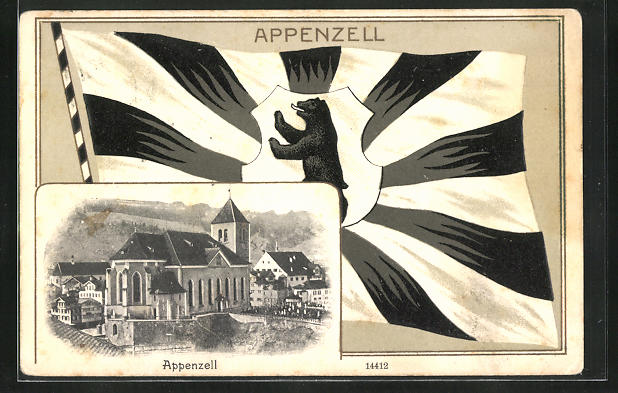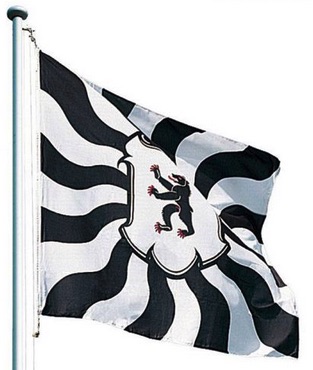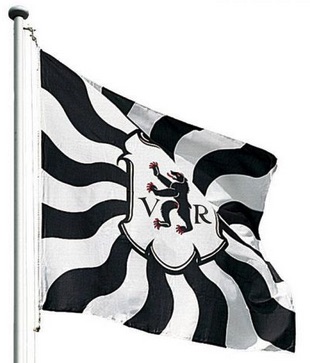
This page is part of © FOTW Flags Of The World website
Appenzell canton (Switzerland)
Last modified: 2025-05-17 by martin karner
Keywords: switzerland | appenzell | bear | german |
Links: FOTW homepage |
search |
disclaimer and copyright |
write us |
mirrors
![[Flag of Appenzell]](../images/c/ch-ap.gif) image
by António Martins
image
by António Martins
See also:
- Appenzell Ausserrhoden canton
- Appenzell Innerrhoden canton
- Switzerland
- Regio Bodensee
- RAMPANT, PRIAPIC IN ITS VIRILITY in Dictionary of Vexillology
- Der Bär, als Wappen des Kantons Appenzell (by Appenzellisches Monatsblatt, 1827, German)
- Der st. gallisch-appenzellische Wappenhandel [1579] (by Jahrbuch der Stadt St. Gallen, 1943, German)
- Die Appenzeller Fahnen (by Rainald Fischer, 1974, German)
- Wappen, Siegel und Fahnen des Appenzellerlandes (by Johannes Schläpfer, 1993, German)
- Das Appenzeller Fahnenbuch (by Heidi Eisenhut, 2013, German)
Description of the Flag
Argent, a bear rampant sable, armed langued
and priapic in his virility gules.
On a white field, an upright black bear with red claws and a red
erect penis.
When a single flag or arms for both half-cantons is required, that of
Appenzell Innerrhoden is displayed.
T.F. Mills, 28 October 1997
Symbolism of the Flag
The bear is a symbol of power, courage, might and virility. The
symbolism of this particular bear is explained by its history.
T.F. Mills, 28 October 1997
History of the Flag
The bear is that of the Abbot of St. Gallen who was the liege lord
of Appenzell until 1403 when the district rebelled and seceded.
They adopted the same flag, changing the field from yellow to white
and adding an erection on the bear as a defiant political gesture.
Appenzell almost went to war with St. Gallen in 1579 when a printer
of that city published a calendar ornamented with the arms of the
Swiss cantons, and ignorantly turned Appenzell's bear into a female
(simply by leaving off the penis). War was avoided when the printer
offered abject apologies and St. Gallen destroyed every copy of the
calendar they could find.
Appenzell previously had a flag, granted by the abbot, depicting a
bear walking on all fours ("marchant") on a honeycombed field
(That flag has been documented as far back as 1377). The bear of
St. Gallen and Appenzell originated in a legend about the Irish
missionary. St. Gallus encountered a hungry bear, and, rather than
flee or fight, the missionary gave the bear a piece of bread. The
bear in gratitude brought him logs to help build a cabin, and around
the cabin grew the famous monastery.
The Reformation led to a split of Appenzell in 1597, Innerrhoden
remaining Catholic, and Ausserrhoden becoming Zwinglian (Protestant).
Innerrhoden kept its old battle flag, Ausserrhoden
differentiated their flag by adding the Latin letters "V" and "R",
standing for "Vssere (ussere) Rhoden" (outer Rhoden). Switzerland was overrun by
the forces of the French Revolution in 1798, and occupation troops
destroyed most Swiss flags which they could find. Appenzell
Ausserrhoden saved its flags, however, when a quick-witted local
explained to the French that "V R" stood for "Vive la République".
Before it split, Appenzell entered the Swiss Confederation in 1514.
That state had already been allied with the Swiss since 1411.
The admission of Appenzell brought the membership of the
Confederation to thirteen (not counting half-cantons), a mystical
number which remained intact for almost three hundred years, and
which proved itself eminently capable of fighting off the claims of
powerful neighbours. Their total independence from the German
Empire was formally recognised in the Treaty of Westphalia, ending
the Thirty Years War in 1648.
T.F. Mills, 28 October 1997
Since the adoption of the new Constitution in 1999, there isn't anymore
any "half-canton". The effective difference between a full and a half
canton is the fact that a "half-canton" has only one representative in the
Swiss States Council while the other cantons have two.
In the new Constitution, the old "half-cantons" are listed as those
cantons that have only one representative (Basel-Stadt, Baselland, Appenzell
Innerrhoden, Appenzell Ausserrhoden, Nidwalden and Obwalden).
Pascal Prince, 24 August 2007
In fact the term "half-canton" (or semi-canton) was never in the Swiss Constitution (although it was
used in official documents and legislative texts). The only thing that changed in 1999 was that the
half-cantons were now called cantons, even officially. However, the actual status of these cantons has not
changed since 1848 (the new federal state). Although only represented with one vote in the State Chamber
(Ständerat), they always had the same status as a full canton. Regardless of this, the term "half-canton"
is used unchanged in the population and in the geographical and cultural context (i.e. also in
vexillology).
The common flag depicted here has only a cultural (and sometimes military) meaning, but no political one
since the partition of 1597. Since then there has been no political entity named "Appenzell canton" or
"State of Appenzell" (This also applies to the other "common flags" of the semi-cantons, see
Basel and Unterwalden).
Martin Karner, 11 January 2023
The concept of half-cantons is indeed somewhat strange and only understandable against the backgound of
Swiss history. As T.F. Mills wrote somewhere else, the divided cantons have a past when they weren't divided yet. The causes of
partition were different. In the case of
Appenzell denominational dissension was the reason. The outer parts of Appenzell adopted the Reformation,
while the inner parts stayed Catholic.
The other states/cantons didn't accept that the new formed cantons had each two representatives in the
Assembly of the Confederation (Tagsatzung) because that would have doubled their weight in comparison to
the situation before the partition. Therefore the new cantons had to limit themselves to send only one
delegate each to the Assembly. So the old balance of power was maintained. Thus came the notation
"half-canton", it's referring only to the half representation in the Assembly (today: Council of States,
Ständerat) but not to their status as a full member of the Confederation.
Martin Karner, 11 January 2023
On a page dedicated to the pre-1597 land of Appenzell of the
Historical Lexicon of Switzerland
an Appenzell flag from the Swabian War of 1499 is shown
(picture). Black bear with red arms on white
field. Location: Museum Appenzell, Appenzell
Martin Karner, 11 January 2023
Oldest known banner of Appenzell (b/w), around 1401 (not earlier),
with sewn Schwenkel. Location: Swiss National Museum, Zurich (source).
Colour Flag
![[Flag of Appenzell]](../images/c/ch-ap_56.gif) image
by Ole Andersen
image
by Ole Andersen
Simple rectangular cantonal flag, as shown in Kannik (1956). Common for
both half-cantons [So-called colour flag (Farbenfahne in German)].
Ole Andersen, 4 August 2002


 images located by Martin Karner
images located by Martin Karner
(Postmark: 1909 | source)
(source)
(source)
At the beginning of the 20th century, flamed flags were still in use, with the white cross replaced by
a (baroque) shield in the centre of the flag. These decorative flags had been used until WWII and then
somewhat forgotten in preference of the current cantonal flags. [Today they are being
produced again, see images on the right]
Pascal Gross, 30 June 2002
See also:


 images located by Martin Karner
images located by Martin Karner
![[Flag of Appenzell]](../images/c/ch-ap.gif) image
by António Martins
image
by António Martins![[Flag of Appenzell]](../images/c/ch-ap_56.gif)